Realtek Semiconductor RTL8723AS 802.11 b/g/n RTL8723AS combo module User Manual 1 of 2
Realtek Semiconductor Corp. 802.11 b/g/n RTL8723AS combo module Users Manual 1 of 2
Contents
- 1. User Manual
- 2. Users Manual - 1 of 2
- 3. Users Manual - 2 of 2
- 4. Host System Manual -1
- 5. Host System Manual -2
Users Manual - 1 of 2

Lenovo IdeaPad
Yoga 13
Read the safety notices and important tips in the
included manuals before using your computer.
©Lenovo China 2012
New World. New Thinking.TM
www.lenovo.com
V1.0_en-US
User Guide V1.0

First Edition (June 2012)
© Copyright Lenovo 2012.
Before using the product, be sure to read Lenovo Safety and General
Information Guide first.
The features described in this guide are common to most models.
Some features may not be available on your computer and/or your
computer may include features that are not described in this user
guide.
Some instructions in this guide may assume that you are using
Windows® 8. If you are using other Windows operating system, some
operations may be slightly different. If you are using other operating
systems, some operations may not apply to you.
LIMITED AND RESTRICTED RIGHTS NOTICE: If data or software is delivered pursuant a General
Services Administration “GSA” contract, use, reproduction, or disclosure is subject to restrictions set
forth in Contract No. GS-35F-05925.
Note
•
•
•
The illustrations in this manual may differ from the actual product.
Please refer to the actual product.
•
To refer to it, go to http://consumersupport.lenovo.com/ and click
User guides and manuals.
Regulatory Notice
•
i
Chapter 1. Getting to know your computer ..........................................1
Top view.......................................................................................................................1
Left-side view ..............................................................................................................3
Right-side view............................................................................................................4
Front view ....................................................................................................................5
Bottom view .................................................................................................................6
Chapter 2. Learning the basics..............................................................7
First use.........................................................................................................................7
Using AC adapter and battery ................................................................................10
Using multi-touch display .......................................................................................11
Using the touchpad...................................................................................................12
Using the keyboard...................................................................................................13
Connecting external devices....................................................................................16
Special keys and buttons..........................................................................................19
System status indicators...........................................................................................21
Using the computer in stand, tent or tablet mode................................................23
Windows 8 overview................................................................................................26
Securing your computer...........................................................................................29
Chapter 3. Connecting to the Internet.................................................30
Wireless connection ..................................................................................................30
Chapter 4. OneKey Rescue system.....................................................31
OneKey Rescue system ............................................................................................31
Chapter 5. Troubleshooting ................................................................. 34
Frequently asked questions .....................................................................................34
Troubleshooting ........................................................................................................36
Trademarks............................................................................................ 41
Contents
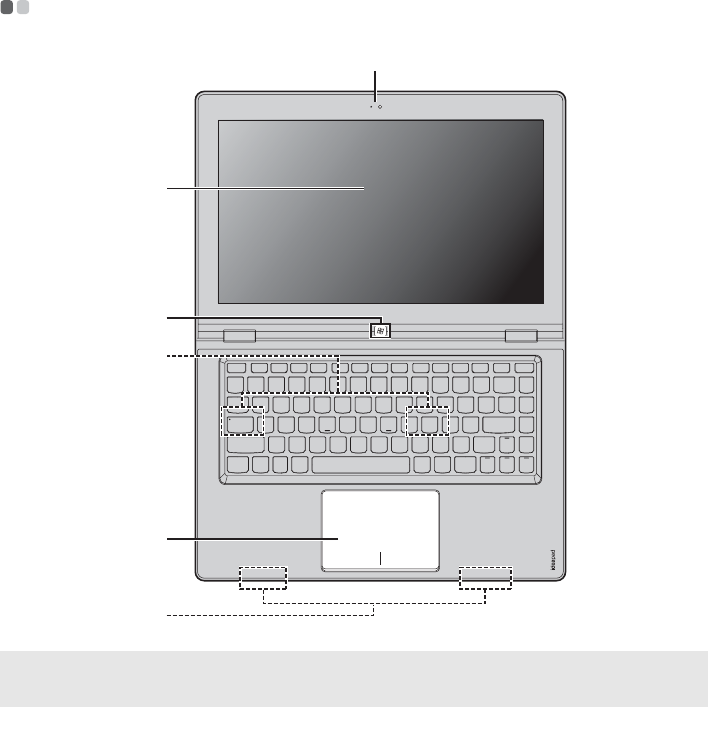
1
Chapter 1. Getting to know your computer
Top view - - - - - - - - - - - - - - - - - - - - - - - - - - - - - - - - - - - - - - - - - - - - - - - - - - - - - - - - - - - - - - - - - - - - - - - - - - - - - - - - - - - - - - - - - - - - - - - - - - -
Note: The illustrations in this manual may differ from the actual product. Please refer to the
actual product.
Attention:
•The parts bounded by dashed lines are internally installed.
a
b
e
d
c
f

2
Chapter 1. Getting to know your computer
Integrated
camera
Use the camera for video communication.
Multi-touch
display
The LCD display with LED backlight provides brilliant
visual output. Multi-touch function is available on this
display.
MS button Press this button to switch between the current screen and
Home screen.
SpeakerThe stereo speaker provides rich and powerful sound.
Touchpad The touchpad functions as a conventional mouse.
Note: For details, see “Using multi-touch display” on page 11.
Wireless module
antennas
The built-in antennas ensure optimal reception of wireless
radio.
a
b
c
d
e
f
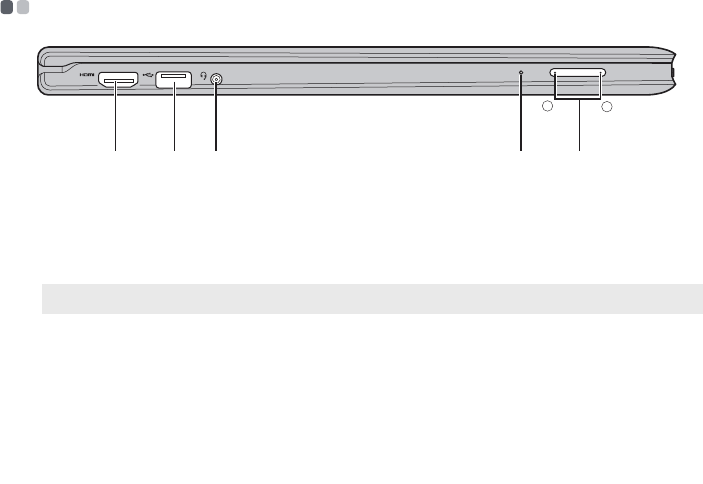
Chapter 1. Getting to know your computer
3
Left-side view - - - - - - - - - - - - - - - - - - - - - - - - - - - - - - - - - - - - - - - - - - - - - - - - - - - - - - - - - - - - - - - - - - - - - - - - - - - - - - - - - - - - - -
HDMI port Connects to devices with HDMI input such as a TV or a
display.
USB port Connect to USB devices.
Note:For details, see “Connecting USB devices” on page 17.
Combo audio
jack
Connects to headphones or headsets. The combo audio
jack supports conventional microphones.
Built-in
microphone
The built-in microphone (with noise reduction) can be
used for video conferencing, voice narration, or simple
audio recordings.
Volume button Use this button to adjust volume.
+ : Increase sound volume.
- : Decrease sound volume.
a b edc
a
b
c
d
e
+
-
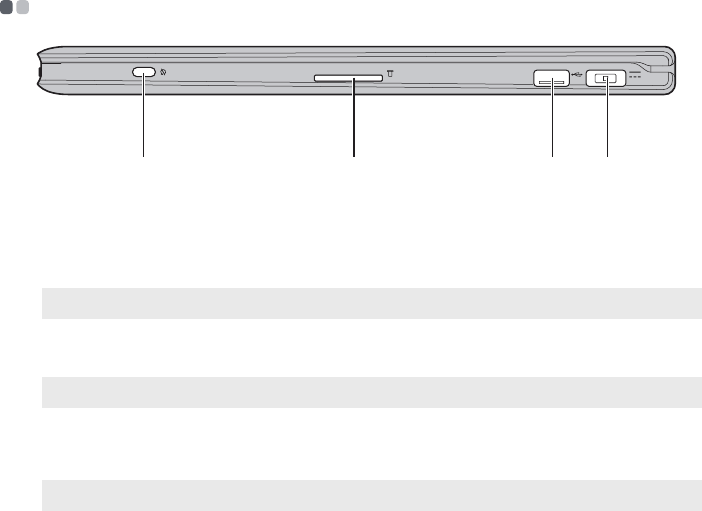
4
Chapter 1. Getting to know your computer
Right-side view - - - - - - - - - - - - - - - - - - - - - - - - - - - - - - - - - - - - - - - - - - - - - - - - - - - - - - - - - - - - - - - - - - - - - - - - - - - - - - - - - -
Rotation button Press this button to rotate the screen to a landscape or
portrait orientation.
Memory card slot Insert memory cards (not supplied) here.
Note: For details, see “Using memory cards (not supplied)” on page 16.
USB port Connects to USB devices.
Note: For details, see “Connecting USB devices” on page 17.
AC power adapter
jack
Connect the AC adapter here.
Note: For details, see “Using AC adapter and battery” on page 10.
a b
c d
a
b
c
d
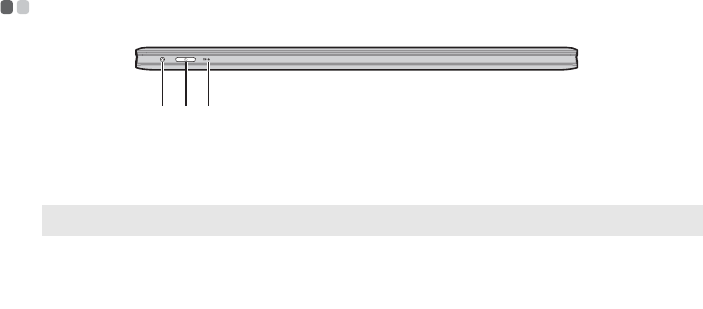
Chapter 1. Getting to know your computer
5
Front view - - - - - - - - - - - - - - - - - - - - - - - - - - - - - - - - - - - - - - - - - - - - - - - - - - - - - - - - - - - - - - - - - - - - - - - - - - - - - - - - - - - - - - - - - - - - - - -
OneKey Rescue
system button
Press this button to start the OneKey Rescue system when
the computer is powered off.
Note: For details, see “OneKey Rescue system” on page 31.
Power button Press this button to turn on the computer.
System status
indicators
For details, see “System status indicators” on page 21.
ab
c
a
b
c

6
Chapter 1. Getting to know your computer
Bottom view - - - - - - - - - - - - - - - - - - - - - - - - - - - - - - - - - - - - - - - - - - - - - - - - - - - - - - - - - - - - - - - - - - - - - - - - - - - - - - - - - - - - - - - - - -
Louvers Allow air to enter the computer for cooling.
a
a

7
Chapter 2. Learning the basics
First use
- - - - - - - - - - - - - - - - - - - - - - - - - - - - - - - - - - - - - - - - - - - - - - - - - - - - - - - - - - - - - - - - - - - - - - - - - - - - - - - - - - - - - - - - - - - - - - - - - - - - - - -
Reading the manuals
Read the supplied manuals before using your computer.
Conncting to the power
The built-in battery pack is not fully charged at purchase.
To charge the battery and begin using your computer, connect the computer
to an electrical outlet. The battery is automatically charged while the
computer is running on AC power.
Connecting the computer to an electrical outlet
1
Connect the power cord to the AC adapter.
2
Connect the AC adapter to the AC power adapter jack of the computer
firmly.
3
Plug the power cord into an electrical outlet.
Turning on the computer
Press the power button to turn on the computer.
Configuring the operating system
You may need to configure the operating system when it is first used. The
configuration process may include the procedures below.
• Accepting the end user license agreement
• Configuring the Internet connection
• Registering the operating system
• Creating a user account
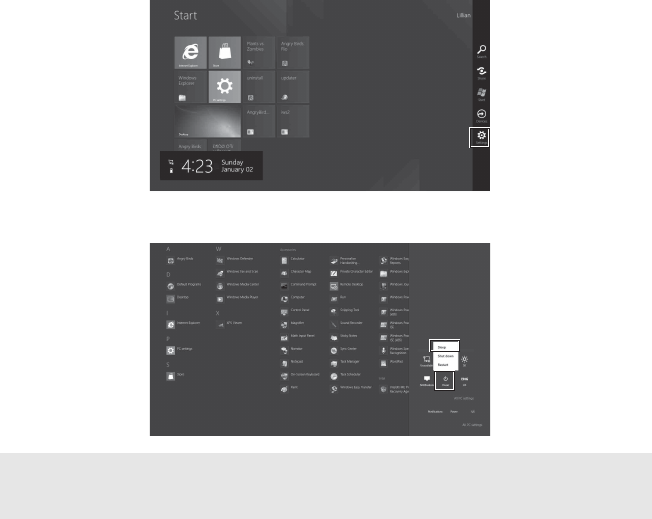
8
Chapter 2. Learning the basics
Putting your computer into Sleep mode or shutting it down
When you finish working with your computer, you can put it into Sleep
mode or shut it down.
Putting your computer into Sleep mode
If you will be away from your computer for only a short time, put the
computer into Sleep mode.
When the computer is in Sleep mode, you can quickly wake it to resume use,
and bypass the startup process.
1
Swipe in from the right edge of the screen or point to the lower right
corner of the screen Settings, and then tap Settings.
2
Tap or click Power and then select Sleep.
Note: Wait until the power indicator light starts blinking (indicating that the computer is
in Sleep mode) before you move your computer. Moving your computer while the
hard disk is spinning can damage the hard disk, causing loss of data.
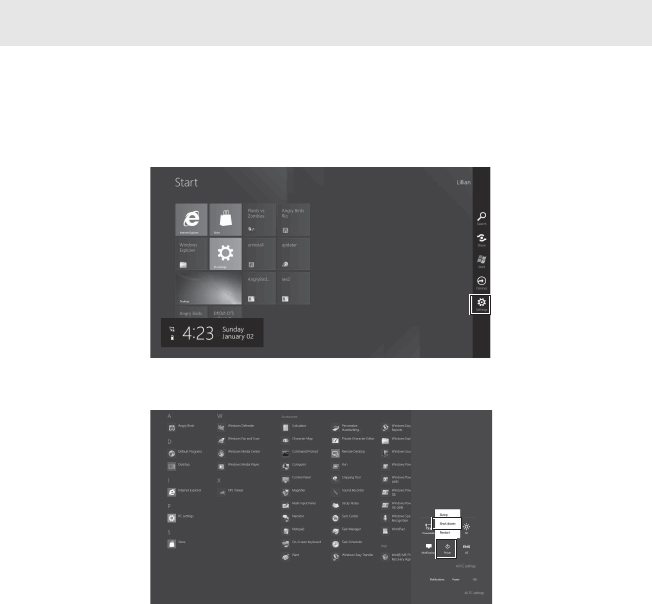
Chapter 2. Learning the basics
9
To wake the computer, do one of the following.
• Press the power button.
• Press any key on the keyboard, if the key board is not locked.
• Press the MS button.
Shutting down your computer
1
Swipe in from the right edge of the screen or point to the lower right
corner of the screen Settings, and then tap Settings.
2
Tap or click Power and then select Shut down.
Note: keyboard will be locked automatically, when the screen is opened more than 180
degrees.

10
Chapter 2. Learning the basics
Using AC adapter and battery
- - - - - - - - - - - - - - - - - - - - - - - - - - - - - - - - - - - - - - - - - - - - - - - - - - - - - - - - - -
Checking battery status
You can determine the percentage of battery power remaining by checking
the battery icon in the notification area.
Charging the battery
If the battery power is low, you need to charge the battery.
You need to charge the battery in any of the following situations:
• If the battery status indicator starts blinking
• If the battery has not been used for a long time
Battery Protection
If the battery pack remains idle for a long time, the battery may be
over-discharged, and its degradation speed may be increased. The battery
pack of IdeaPad Yoga series uses the battery protection technology. When
your computer remains idle for a long time, the battery pack enters the
hibernation mode to avoid over-discharge. After the battery pack enters the
hibernation mode, you cannot turn the computer on without using the
power adapter. Please connect the power adapter to the computer to activate
the battery pack.
Note: As each computer user has different habits and needs, it is difficult to predict how
long a battery charge will last. There are two main factors:
• The amount of energy stored in the battery when you commence work.
• The way you use your computer: for example, how often you access the hard disk
drive and how bright you make the computer display.
Note:
•To increase the life of the battery pack, the computer does not start recharging the
battery immediately after it drops from fully charged.
•Charge the battery at a temperature between 50 °F and 86 °F (10 °C-30 °C).
•Full charge or discharge is not required.
Note: The batter pack is in the hibernation mode by default. When you use the computer
for the first time, please plug the power adapter into it. Otherwise, the computer
cannot be turned on.
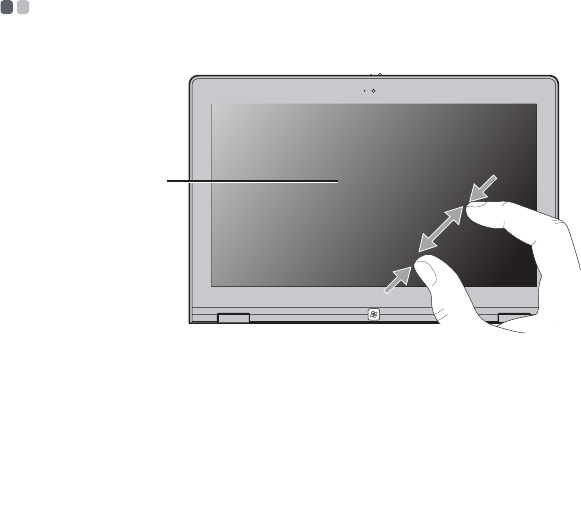
Chapter 2. Learning the basics
11
Using multi-touch display
- - - - - - - - - - - - - - - - - - - - - - - - - - - - - - - - - - - - - - - - - - - - - - - - - - - - - - - - - - - - - - - - - -
Multi-touch display The display supports multi-touch function. You
can touch, swipe and tap directly without the
use of the keyboard or touchpad.
a
a
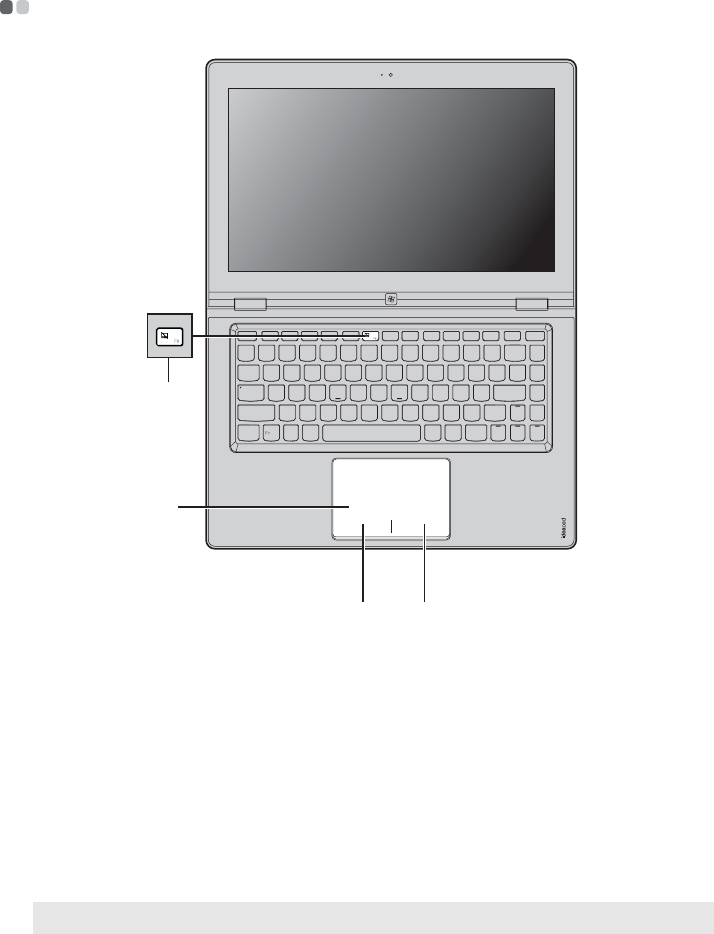
12
Chapter 2. Learning the basics
Using the touchpad
- - - - - - - - - - - - - - - - - - - - - - - - - - - - - - - - - - - - - - - - - - - - - - - - - - - - - - - - - - - - - - - - - - - - - - - - - - - - - - -
Touchpad To move the cursor on the screen, slide your
fingertip over the pad in the direction in which
you want the cursor to move.
Left-click area The function corresponds to that of the left
mouse button on a conventional mouse, which
can be implemented by clicking this area.
Right-click area The function corresponds to that of the right
mouse button on a conventional mouse, which
can be implemented by clicking this area.
Note: You can enable/disable the touchpad by pressing .
b c
a
d
a
b
c
d

Chapter 2. Learning the basics
13
Using the keyboard
- - - - - - - - - - - - - - - - - - - - - - - - - - - - - - - - - - - - - - - - - - - - - - - - - - - - - - - - - - - - - - - - - - - - - - - - - - - - - - -
Your computer has function keys incorporated in its standard keyboard.
Function key combinations
By pressing the appropriate function keys, you can change system settings
instantly. To use this function, press and hold Fn , then press one of the
function keys .
The following describes the features of each function key.
Fn + Home: Activate the pause function.
Fn + End: Activate the break function.
Fn + PgUp: Enable/Disable the scroll lock.
Fn + PgDn: Activate the insert function.
a
b
b
a

14
Chapter 2. Learning the basics
Hotkeys
Using hotkeys
The hotkeys are located in the function key row of the keyboard.
By pressing the appropriate hotkey, you can change system settings instantly.
The following describes the function of each hotkey.
: Mute/Unmute. : Decrease sound volume.
: Increase sound volume. : Close active window or
program.
: Refresh desktop or Web
pages. : Enable/Disable the
touchpad.
:
Open the interface for
integrated wireless devices
settings (on/off).
: Enable/Disable the built-in
microphone.
: Turn on/off the integrated
camera. : Open the interface for
changing display devices.
: Decrease display brightness. : Increase display brightness.

Chapter 2. Learning the basics
15
Setting hotkey mode
By default, the hotkey functions are accessible by pressing the appropriate
hotkey. However, you can disable the hotkey mode in the BIOS setup utility.
To disable the hotkey mode:
1
Restart the computer. When the Lenovo logo appears, immediately press
Fn + F2 to enter the BIOS setup utility.
2
In the BIOS setup utility, open the Configuration menu, and change the
setting of Hot key function from Enabled to Disabled.
3
Open the Exit menu, and select Exit Saving Changes.
Note: When hotkey mode is disabled, press the Fn key and the appropriate hotkey to access
the corresponding hotkey function.

16
Chapter 2. Learning the basics
Connecting external devices
- - - - - - - - - - - - - - - - - - - - - - - - - - - - - - - - - - - - - - - - - - - - - - - - - - - - - - - - - - - -
Your computer has a wide range of built-in features and connection
capabilities.
Using memory cards (not supplied)
Your computer supports the following types of memory cards:
• Secure Digital (SD) card
• MultiMediaCard (MMC)
Inserting a memory card
1
Push the dummy card until you hear a click. Gently pull the dummy card
out of the memory card slot.
2
Slide the memory card in until it clicks into place.
Removing a memory card
1
Push the memory card until you hear a click.
2
Gently pull the memory card out of the memory card slot.
Note:
•Insert ONLY one card in the slot at a time.
•This card reader does not support SDIO devices (e.g., SDIO Bluetooth, etc.).
Note: The dummy card is used for preventing dust and small particles from entering the
inside of your computer when the memory card slot is not in use. Retain the dummy
card for future use.
Note: Before removing the memory card, disable it via Windows safely remove hardware
and eject media utility to avoid data corruption.
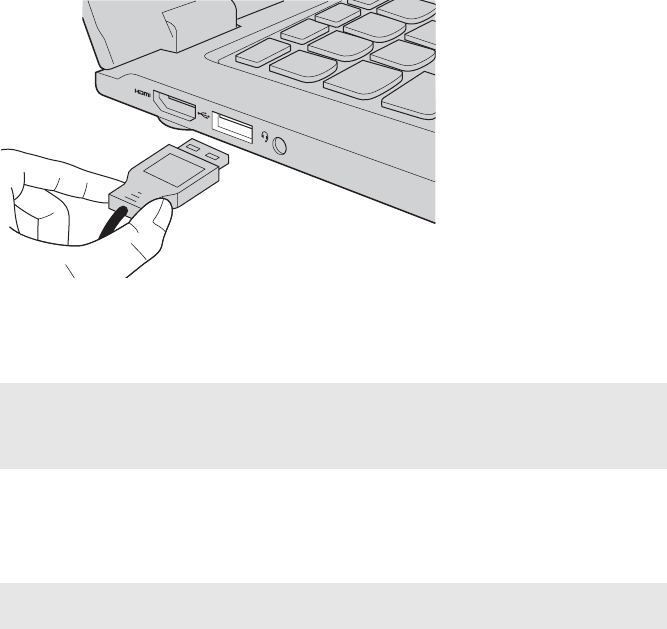
Chapter 2. Learning the basics
17
Connecting USB devices
You can connect a USB device to your computer by inserting its USB plug
(Type A) into the USB port on your computer.
The first time you plug a USB device into a particular USB port on your
computer, Windows automatically installs a driver for that device. After the
driver is installed, you can disconnect and reconnect the device without
performing any additional steps.
Before disconnecting a USB storage device, make sure your computer has
finished transferring data by that device. Click the Safely Remove Hardware
icon in the notification area of Windows to remove the device before
disconnecting.
Note: Typically, Windows detects a new device after connecting it, and then installs the
driver automatically. However, some devices may require you to install the driver
before connecting. Check the documentation provided by the device’s manufacturer
before connecting the device.
Note: If your USB device uses a power cord, connect the device to a power source before
connecting it. Otherwise, the device may not be recognized.
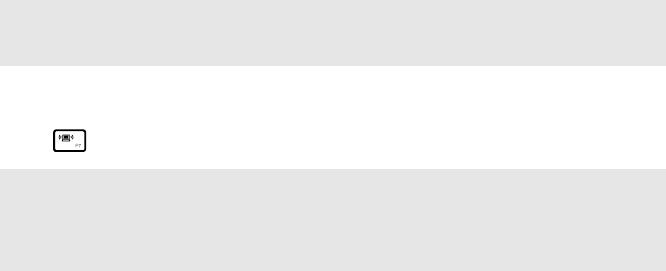
18
Chapter 2. Learning the basics
Connecting Bluetooth enabled device (on select models)
If your computer has an ieocntegrated Bluetooth adapter card, it can connect
to and transfer data wirelessly to other Bluetooth enabled devices, such as
notebook computers, PDAs and cell phones. You can transfer data between
these devices without cables and up to 10 meters range in open space.
Enabling Bluetooth communications on your computer
Press to make configuration.
Note: The actual maximum range may vary due to interference and transmission barriers. To
get the best possible connection speed, place the device as near your computer as
possible.
Note:
•When you do not need to use the Bluetooth function, turn it off to save battery power.
•You need to pair the Bluetooth enabled device with your computer before you can transfer
data between them. Read the documentation supplied with the Bluetooth enabled device
for details on how to pair the device with your computer.
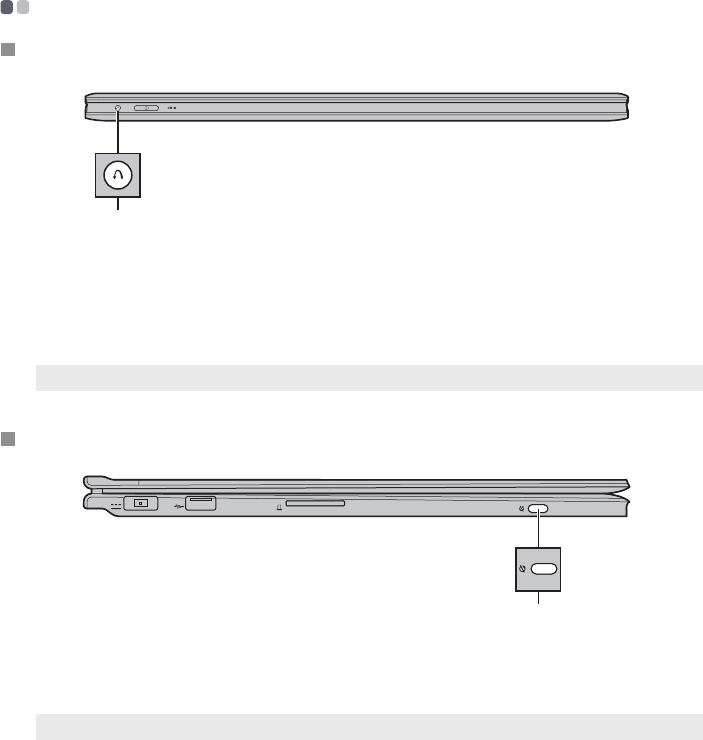
Chapter 2. Learning the basics
19
Special keys and buttons
- - - - - - - - - - - - - - - - - - - - - - - - - - - - - - - - - - - - - - - - - - - - - - - - - - - - - - - - - - - - - - - - - - -
OneKey Rescue system button
•When the computer is powered off, press this button to start the OneKey
Rescue system.
•In the Windows operating system, press this button to start the Lenovo
OneKey Recovery system.
Rotation button
Press this button to rotate the screen to a landscape or portrait orientation
in the tablet mode.
Note:For details, see “OneKey Rescue system” on page 31.
Note:For details, see “Changing the orientation in tablet mode” on page 25.
a
a
a
a
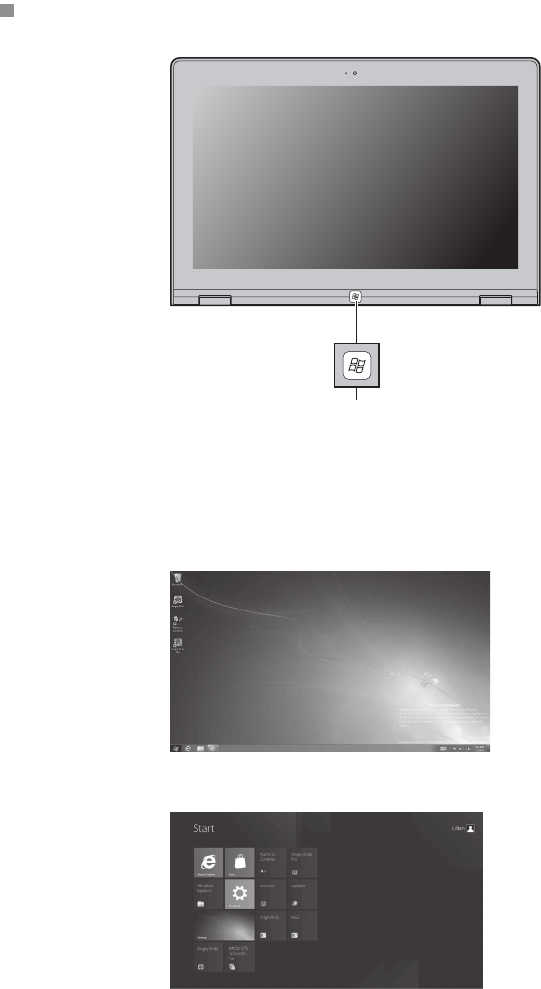
20
Chapter 2. Learning the basics
MS button
Press this button to switch between the current screen and Home screen
(Desktop or Home).
Desktop screen
Home screen
a
a
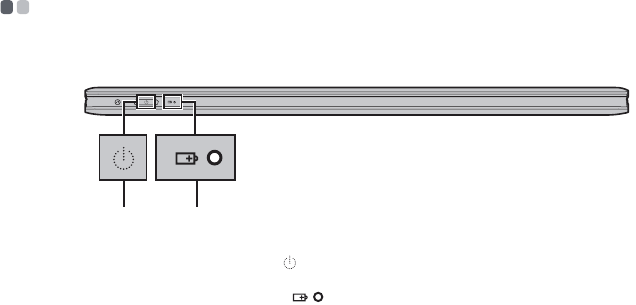
Chapter 2. Learning the basics
21
System status indicators
- - - - - - - - - - - - - - - - - - - - - - - - - - - - - - - - - - - - - - - - - - - - - - - - - - - - - - - - - - - - - - - - - - - -
These indicators inform you of the computer status.
ba
Power status indicator
Battery status indicator
a
b
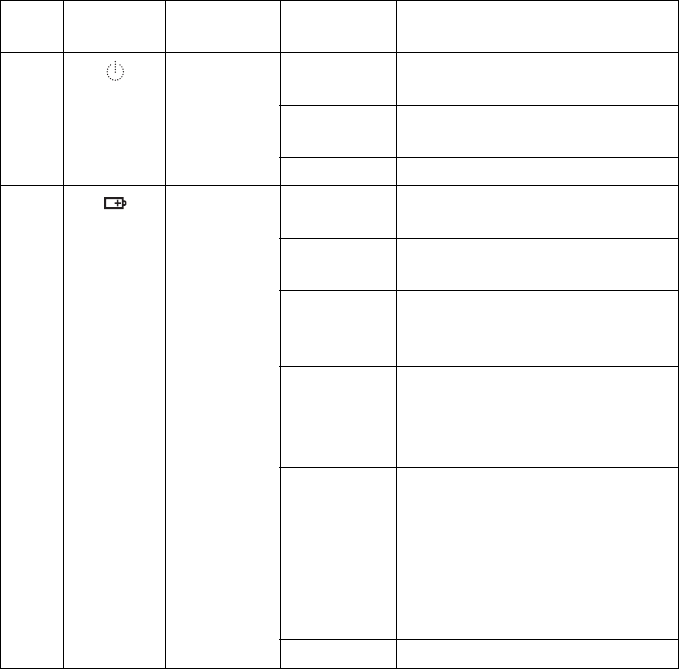
22
Chapter 2. Learning the basics
No. Symbol Indicator Indicator
status
Meaning
Power On (solid
white)
The computer is powered on.
Blinking The computer is in Sleep
mode.
Off The computer is powered off.
Battery On (solid
white)
The battery has more than
20% charge.
Solid
amber
The battery has between 5%
and 20% charge.
Fast
blinking
amber
The battery has less than 5%
charge.
Slow
blinking
amber
The battery is being charged.
When battery charge reaches
20%, the blinking color
changes to white.
Slow
blinking
white
The battery has between 20%
and 80% charge and is still
charging. When the battery
reaches 80% charge the light
will stop blinking, but
charging will continue until
the battery is fully charged.
Off The battery is detached.
a
b

Chapter 2. Learning the basics
23
Using the computer in stand, tent or tablet mode
- - - - - - - - - - - - - - - -
Using the computer in stand mode
Converting to stand mode
Open the computer and fold the display about 280 degrees as shown in the
illustration below.
Using the computer in tent mode
Converting to tent mode
Open the computer and fold the display about 315 degrees as shown in the
illustration below.
确认是否需要描述在何种情况下使
用此模式。
确认是否需要描述在何种情况下使
用此模式。
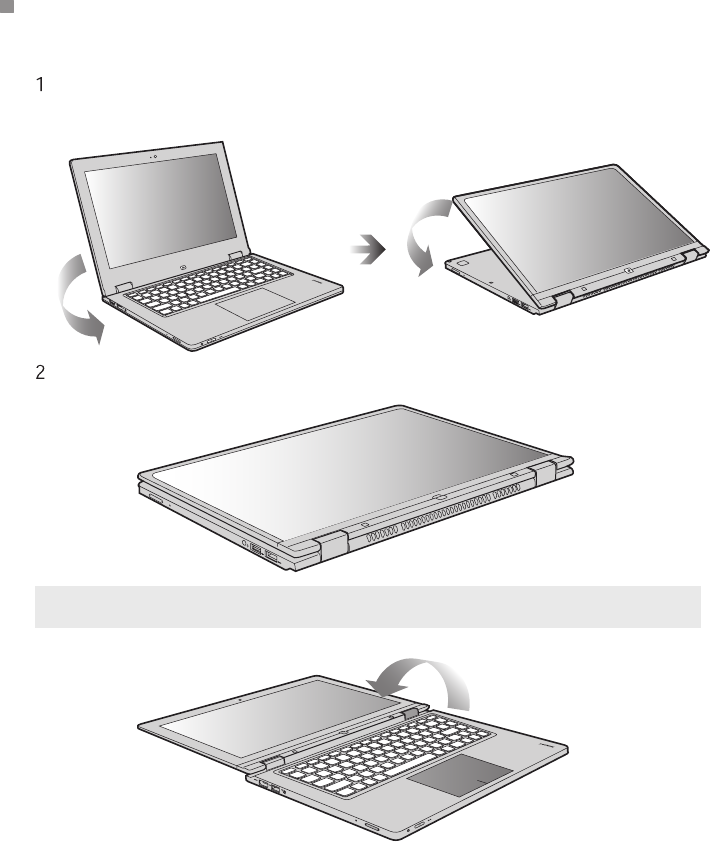
24
Chapter 2. Learning the basics
Using the computer in tablet mode
Open the computer and fold the display 360 degrees as shown in the
illustration below.
Place the computer that the screen facing up.
Note: Keyboard will be locked automatically, when the screen is opened more than 190
degrees.
190 degrees
Converting to tablet mode
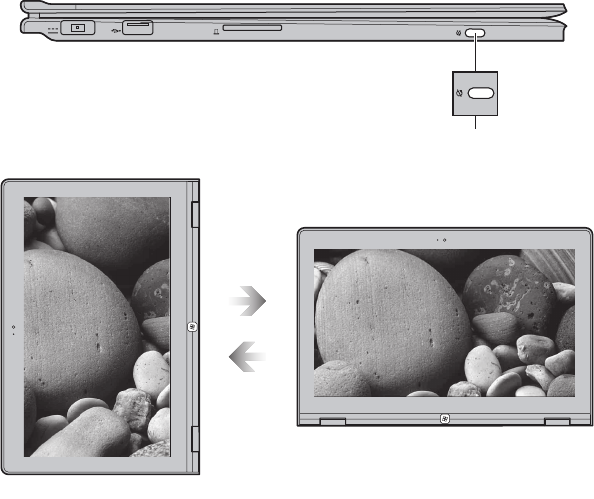
Chapter 2. Learning the basics
25
Changing the orientation in tablet mode
In tablet mode, press the Rotation button to rotate the screen to a landscape
or portrait orientation.
Rotation button
Portrait
Landscape
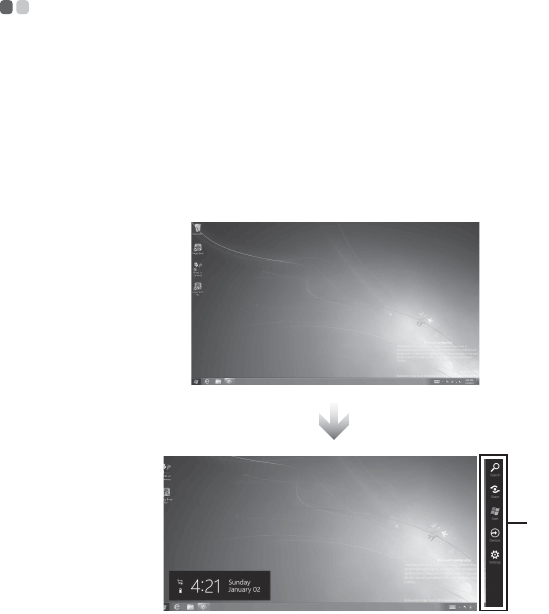
26
Chapter 2. Learning the basics
Windows 8 overview
- - - - - - - - - - - - - - - - - - - - - - - - - - - - - - - - - - - - - - - - - - - - - - - - - - - - - - - - - - - - - - - - - - - - - - - - - - - - -
The charms
The charms provide new and better way to do things you’ve always done.
The charms appear on the right side of your screen. Swipe in from the right
edge or move your mouse to the lower-right corner to see them, and then
choose the one you want.
Search charm
The search charm is a powerful new way to find what you are looking for.
When you enter a search term, you can check results from your PC, the web,
or within different apps - all from the same place.
Share charm
The Share charm lets you send links, photos, and more to your friends and
social networks without leaving the app you are in.
Start charm
The Start charm takes you to Start or, if you are on the Start screen, back to
your last app.
a
a
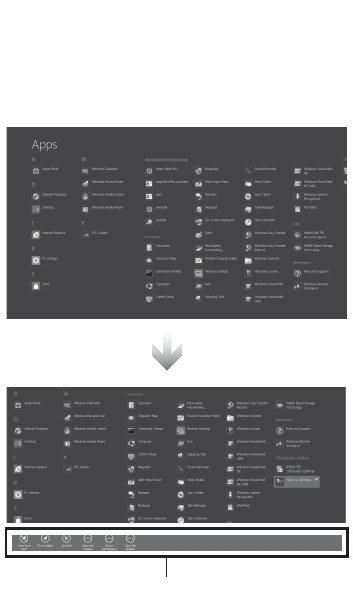
Chapter 2. Learning the basics
27
Devices charm
The Devices charm is a handy way to do things like sending files and
streaming movies to printers,TVs, and more.
Settings charm
The Settings charm is how you do basic tasks like shutting down your PC
and changing the volume. It is also used by apps to configure things like
account and privacy settings.
App commands
The App commands appear at the top and bottom of your screen. Swipe up
or down from either edge or right-click in an open space (no text or images)
to see them, and then choose the one you want.
a
a
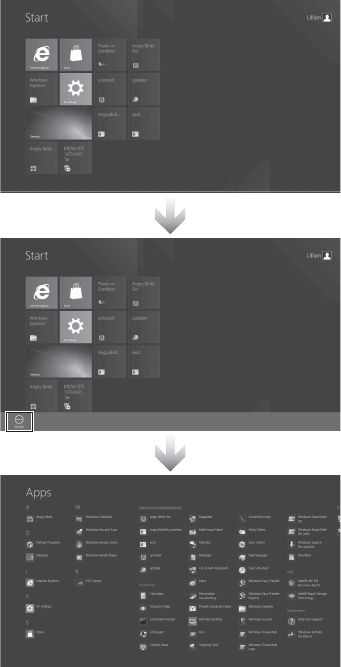
28
Chapter 2. Learning the basics
Apps screen
Apps screen appears by at the bottom edge of your start screen. Swipe up
and tap the All apps or clicking by your mouse.

Chapter 2. Learning the basics
29
Securing your computer
- - - - - - - - - - - - - - - - - - - - - - - - - - - - - - - - - - - - - - - - - - - - - - - - - - - - - - - - - - - - - - - - - - - - -
This section provides information about how to help protect your computer
from theft and unauthorized use.
Using passwords
Using passwords helps prevent your computer from being used by others.
Once you set a password and enable it, a prompt appears on the screen each
time you power on the computer. Enter your password at the prompt. The
computer cannot be used unless you enter the correct password.
For details about how to set the password, see the Help to the right of the
screen in BIOS setup utility.
Note: This password can be from one to seven alphanumeric characters in any combination.
Note: To enter BIOS setup utility, press Fn + F2 (when Hot key function is set to Enabled) or
F2 (when Hot key function is set to Disabled) when the Lenovo logo appears on the
screen while the computer is starting up.

30
Chapter 3. Connecting to the Internet
As a global network, the Internet connects computers worldwide, providing
services such as e-mailing, information searching, electronic commerce, Web
browsing and entertainment.
You can connect the computer to the Internet in the following way:
Wireless network technology: connect without wiring.
Wireless connection - - - - - - - - - - - - - - - - - - - - - - - - - - - - - - - - - - - - - - - - - - - - - - - - - - - - - - - - - - - - - - - - - - - - - - - - - - - -
Wireless connections provide mobile access to the Internet, allowing you to
stay online anywhere the wireless signal covers.
Divided by the signal scales, wireless connection to the Internet can be built
based on the following standards.
Using Wi-Fi/WiMAX (on select models)
Enabling wireless connection
To enable wireless communications, do the following:
Press to make configuration.
Hardware connection
Software configuration
Consult your Internet Service Provider (ISP) and search Windows Help and
Support Center for details on how to configure your computer.
Wi-Fi Wi-Fi networks cover a small physical area, like a home,
office, or small group of buildings. An access point is
necessary for the connection.
WiMAX WiMAX networks connect several Wireless LAN
systems to cover a metropolitan area, providing high-
speed broadband access without the need for cables.
Note: Your computer may not support all wireless connection methods.
Access point *
Wi-Fi/WiMAX network
* Not supplied

31
Chapter 4. OneKey Rescue system
OneKey Rescue system
- - - - - - - - - - - - - - - - - - - - - - - - - - - - - - - - - - - - - - - - - - - - - - - - - - - - - - - - - - - - - - - - - - - - - -
Introduction
The Lenovo OneKey Rescue system is an easy-to-use application that can be
used to back up the data on your system partition (C drive) for easy restore
when required. You can run Lenovo OneKey Recovery under the Windows
operating system, and the OneKey Rescue system without starting the
Windows operating system.
Attention:
In order to utilize the features of the OneKey Rescue system, your hard disk
already includes a hidden partition by default to store the system image file
and OneKey Rescue system program files. This default partition is hidden
for security reasons and is the reason the available disk space is less than it
claims. The exact available hard disk space depends on the file size of the
mirror image file (based on the size of operating system and preinstalled
software).
Using Lenovo OneKey Recovery (within Windows operating
system)
In Windows operating system, double click the OneKey Recovery system
Icon on the desktop to launch Lenovo OneKey Recovery.
Within the program, you can back up the system partition on the hard disk
drive, other storage devices, or by creating recovery discs.
For more instructions, see the Help file of Lenovo OneKey Recovery.
Note:
•The backup process and creation of recovery discs may take some time, connect the AC
adapter and battery pack to your computer.
•After the recovery discs are burned, please number them so that you can use them in the
correct order.
•Computers without an integrated optical drive support the creation of recovery discs;
however an appropriate external optical drive is needed to physically create the recovery
discs.

32
Chapter 4. OneKey Rescue system
Using Lenovo OneKey Rescue system (without Windows
operating system)
In the event that the operating system cannot be loaded, follow the steps
below to access OneKey Rescue system.
• Shut down your computer.
• Press the key to launch OneKey Rescue system.
Within the program, you can choose to restore your system partition to the
original factory status, or to a previously generated backup.
Creating a recovery disc(s)
Your computer does not ship with a recovery disc. You can use Lenovo
OneKey Recovery system to create a recovery disc(s), which can be used to
start and restore your computer in case of a system failure.
To create a recovery disc(s):
• Insert a recordable disc into the optical drive on your computer.
• In Windows, press the OneKey Rescue system button to launch Lenovo
OneKey Recovery system.
• On the main screen, click Create Recovery Disc.
• Choose the type of recovery disc(s). You can create three types of recovery
disc(s): recovery disc(s) with existing backup image, recovery disc(s) from
the current system partition, and factory default recovery disc(s). Select the
type of recovery disc you want to create and follow the on-screen
instructions.
• Insert additional recordable disc(s) when prompted.
Note: The recovery process is irreversible. Make sure to back up any critical data before
using the recovery feature.
Note: If your computer does not come with an integrated optical drive or if the integrated
optical drive does not support disc creating, connect an appropriate external optical
drive to your computer.

Chapter 4. OneKey Rescue system
33
Note:
•The estimated number of discs needed will be displayed before the process of creating the
recovery disc(s) begins. To minimize the number of discs needed, use recordable DVDs as
the media. Also make sure your optical drive is compatible with the disc intended for use.
•After recovery disc creation, number the discs appropriately for use in their correct
order. The first disc created will be used to start the computer in the case of a system
failure.

34
Chapter 5. Troubleshooting
Frequently asked questions - - - - - - - - - - - - - - - - - - - - - - - - - - - - - - - - - - - - - - - - - - - - - - - - - - - - - - - - - - - -
This section lists frequently asked questions and tells where you can find
detailed answers.
What safety precautions should I follow when using my computer?
See “Chapter 1. Important safety information” of Lenovo Safety and General
Information Guide.
How can I prevent problems with my computer?
See “Chapter 2. Use and care Information” of Lenovo Safety and General
Information Guide.
What are the main hardware features of my computer?
More information can be found in Chapter 1 and 2.
Where can I find the detailed specifications for my computer?
See http://consumersupport.lenovo.com.
Where are the recovery discs?
Your computer did not come with a recovery disc. For an explanation of
the alternative recovery methods offered by Lenovo, see “Chapter 4.
OneKey Rescue system” on page 31.
Where are the installation discs for pre-installed software?
Your computer does not come with installation discs for the pre-installed
software. Installation programs for the pre-installed software on your
computer can be downloaded from Lenovo’s consumer support Web site
(http://consumersupport.lenovo.com). If your computer is pre-installed
with Windows operating system, you can also find installation programs
for some pre-installed software in the Application folder on D partition of
the hard disk drive.
How can I contact the customer support center?
See “Chapter 3. Getting help and service” of Lenovo Safety and General
Information Guide.
Chapter 5. Troubleshooting
35
Where can I find warranty information?
For the warranty applicable to your computer, including the warranty
period and type of warranty service, see the Lenovo limited warranty flyer
that came with your computer.
Where can I find the device drivers?
A compatible device driver is a requirement to ensure correct operation
and performance of each component in your computer. All the device
drivers for your computer model can be downloaded from Lenovo’s
consumer support Web site. If your computer is pre-installed with
Windows operating system, you can also find device drivers for the
operating system in the Driver folder on D partition of the hard disk drive.
Lenovo’s consumer support Web site contains the most updated device
drivers.
What can I do if the backup process fails?
If you can start the backup feature without a problem, but it fails during
the backup process, please try the following steps:
1
Close other programs, then restart the backup process.
2
Check if the destination media is damaged, try to select another path
and then try again.
When do I need to restore the system to the factory status?
You can use this feature when your system fails or you need to re-install
your operating system. This will restore your computer back to the initial
status when you first booted up your computer after receiving it from the
store. If there is critical data on your current partition, back it up before you
run this recovery feature.

36
Chapter 5. Troubleshooting
Troubleshooting - - - - - - - - - - - - - - - - - - - - - - - - - - - - - - - - - - - - - - - - - - - - - - - - - - - - - - - - - - - - - - - - - - - - - - - - - - - - - - - - - - - - - -
If you do not find your problem here, see Chapter 2. The following section only
describes problems that might negate the need to refer to the more
comprehensive information in Chapter 2.
Display problems
When I turn on the
computer, nothing appears
on the screen.
•If the screen is blank, make sure that:
- The AC adapter is connected to the computer and
the power cord is plugged into a working electrical
outlet.
- The computer power is on. (Press the power button
again for confirmation.)
•If these items are properly set, and the screen remains
blank, have the computer serviced.
When I turn on the
computer, only a white
cursor appears on a blank
screen.
•Restore backed-up files to your Windows
environment or the entire contents of your hard disk
to the original factory contents using OneKey Rescue
system. If you still see only the cursor on the screen,
have the computer serviced.
My screen goes blank while
the computer is on.
•Your screen saver or power management may be
enabled. Do one of the following to exit from the
screen saver or to resume from Sleep mode:
-Touch the touchpad.
- Press any key on the keyboard.
-Press the power button.

Chapter 5. Troubleshooting
37
Password problems
I forgot my password. •If you forget your user password, you must take your
computer to a Lenovo authorized servicer or a
marketing representative to have the password
changed.
•If you forget your HDD password, a Lenovo
authorized servicer cannot reset your password or
recover data from the hard disk. You must take your
computer to a Lenovo authorized servicer or a
marketing representative to have the hard disk drive
replaced. Proof of purchase is required, and a fee will
be charged for parts and service.
•If you forget your administrator password, a Lenovo
authorized servicer cannot reset your password. You
must take your computer to a Lenovo authorized
servicer or a marketing representative to have the
system board replaced. Proof of purchase is required,
and a fee will be charged for parts and service.
Sleep problems
The critical low-battery error
message appears, and the
computer immediately turns
off.
•The battery power is getting low. Connect the AC
adapter to the computer, or replace the battery with a
fully charged one.
The computer enters
hibernation mode
immediately after Power-on
self-test (POST).
•Make sure that:
- The battery is charged.
- The operating temperature is within the acceptable
range. See “Chapter 2. Use and care Information” of
Lenovo Safety and General Information Guide.
Note: If the battery is charged and the temperature is within range, have the computer serviced.

38
Chapter 5. Troubleshooting
The computer does not
return from hibernation
mode and the computer
does not work.
•If the computer does not return from hibernation
mode, it may have entered hibernation mode
automatically because the battery is depleted. Check
the power indicator.
•If your computer is in hibernation mode, connect the
AC adapter to the computer, then press any key or
the power button.
•If your computer is in hibernation mode or power-off
state, connect the AC adapter to the computer, then
press the power button to resume operation.
Note:
If the system still does not return from hibernation mode, your system has stopped responding,
and you cannot turn off the computer; reset the computer. Unsaved data may be lost. To reset
the computer, press and hold the
power button for 4 seconds or more. If the computer is still
not reset, remove the AC adapter.
Computer screen problems
The screen is blank. •Do the following:
- If you are using the AC adapter, or using the
battery, and the battery status indicator is on, press
to make the screen brighter.
- If the power indicator is in blinking, press the
power button to resume from the hibernation mode.
- If the problem persist, follow the solution in the
following problem “The screen is unreadable or
distorted.”
The screen is unreadable or
distorted.
•Make sure that:
- The display device driver is installed correctly.
- The screen resolution and color quality are correctly
set.
- The monitor type is correct.
Incorrect characters appear
on the screen.
•Did you install the operating system or programs
correctly? If they are installed and configured
correctly, have the computer serviced.

Chapter 5. Troubleshooting
39
Sound problems
No sound can be heard
from the speaker even
when the volume is turned
up.
•Make sure that:
- The Mute function is off.
- The headphone jack is not used.
- The speaker is selected as the playback device.
Battery problems
Your computer shuts down
before the battery status
indicator shows empty.
-or-
Your computer operates
after the battery status indi-
cator shows empty.
•Discharge and recharge the battery.
The computer does not
operate with a fully charged
battery.
•The surge protector in the battery might be active.
Turn off the computer for one minute to reset the
protector; then turn on the computer again.
A hard disk drive problem
The hard disk drive does
not work.
•In the Boot menu in BIOS setup utility, make sure
that the hard disk drive is included in the Boot
Device Priority correctly.
A startup problem
The Microsoft® Windows
operating system does not
start.
•Use the OneKey Rescue system to help solve or
identify your problem. For details about OneKey
Rescue system, see “Chapter 4. OneKey Rescue
system” on page 31.

40
Chapter 5. Troubleshooting
Other problems
Your computer does not
respond.
•To turn off your computer, press and hold the power
button for 4 seconds or more. If the computer still
does not respond, remove the AC adapter.
•Your computer might lock when it enters hibernation
mode during a communication operation. Disable the
hibernation timer when you are working on the
network.
The computer does not
start from a device you
want.
•See the Boot menu of the BIOS setup utility. Make
sure that the Boot Device Priority in the BIOS setup
utility is set so that the computer starts from the
device you want.
•Also make sure that the device from which the
computer starts is enabled. In the Boot menu in the
BIOS setup utility, make sure that the device is
included in the Boot Device Priority list.
•Press Fn + F12 (when Hot key function is set to
Enabled) or F12 (when Hot key function is set to
Disabled) when the Lenovo logo appears on the
screen while the computer is starting up to select the
device you want the computer starts from.
The connected external
device does not work.
•Do not connect or disconnect any external device
cables other than USB while the computer power is
on; otherwise, you might damage your computer.
•When using a high power consumption external
devices such as an external USB optical disk drive,
use external device power adapter. Otherwise, the
device may not be recognized, or system shut down
may result.
41
Trademarks
The following terms are trademarks or registered trademarks of Lenovo in
the United States, other countries, or both.
Lenovo
IdeaPad
OneKey
Microsoft and Windows are trademarks of Microsoft Corporation in the
United States, other countries, or both.
Other company, products, or service names may be trademarks or service
marks of others.
The illustrations in this manual may differ from the actual product.
Please refer to the actual product.
•
First Edition (March 2011)
To refer to it, go to http://consumersupport.lenovo.com/ and click
User guides and manuals.
Regulatory Notice
•
© Copyright Lenovo 2011.
Before using the product, be sure to read Lenovo Safety and General
Information Guide first.
The features described in this guide are common to most models.
Some features may not be available on your computer and/or your
computer may include features that are not described in this user
guide.
Some instructions in this guide may assume that you are using
Windows® 7. If you are using other Windows operating system, some
operations may be slightly different. If you are using other operating
systems, some operations may not apply to you.
LENOVO products, data, computer software, and services have been developed exclusively at private
expense and are sold to governmental entities as commercial items as defined by 48 C.F.R. 2.101 with
limited and restricted rights to use, reproduction and disclosure. LIMITED AND RESTRICTED
RIGHTS NOTICE: If products, data, computer software, or services are delivered pursuant a General
Services Administration “GSA” contract, use, reproduction, or disclosure is subject to restrictions set
forth in Contract No. GS-35F-05925.
Notes
•
•
•
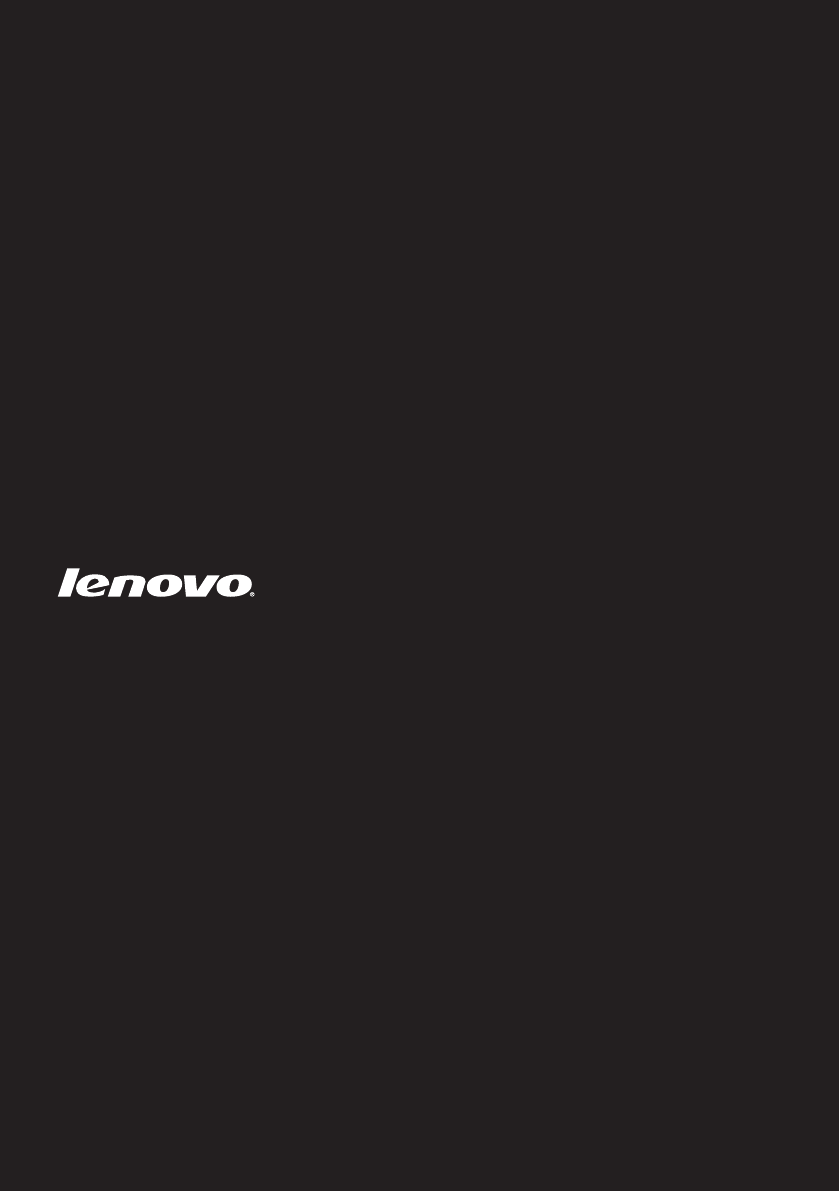
Lenovo IdeaPad
S200/S206
Read the safety notices and important tips in the
included manuals before using your computer.
©Lenovo China 2012
New World. New Thinking.TM
www.lenovo.com
V1.0_en-US
User Guide V1.0